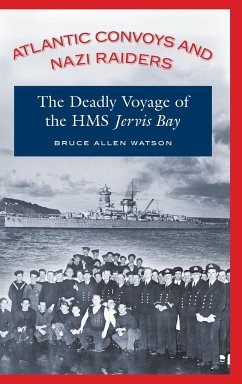In November of 1940, the German pocket battleship Admiral Scheer attacked British Convoy HX-84. The merchant cruiser HMS Jervis Bay, a converted passenger liner that was the convoy's only escort-armed only with antique 6-inch guns-charged the Nazi raider. While the Jervis Bay did not stand a chance of surviving the battle, her crew's fatalistic bravery inspired awe in all who witnessed the fight. Watson recounts how the Scheer's 11-inch guns turned the ship into a burning hulk in twenty-two minutes, but most of the convoy escaped. In November of 1940, the German pocket battleship Admiral Scheer attacked British Convoy HX-84. The Armed Merchant Cruiser HMS Jervis Bay, the only escort and mounting antique 6-inch guns, charged the Nazi raider. While the Jervis Bay did not stand a chance of surviving the battle, her crew's fatalistic bravery inspired awe in all who witnessed the fight. Watson describes how the Scheer's 11-inch guns turned the converted passenger liner into a burning hulk in twenty-two minutes, but most of the convoy escaped. How did this confrontation come to pass? Both the necessity of arming a passenger liner and pretending it was a warship, and the building of the Admiral Scheer and her sister ships for the express purpose of commerce raiding, find their roots in the events, political decisions, re-armament polices, war plans, naval traditions, and blunders that arose in pre-war Britain and Germany. But this event holds a significance beyond the battle itself. The sinking of the Jervis Bay symbolizes the end of an era in naval warfare. The Armed Merchant Cruisers of the Second World War inherited a long, sometimes noble and sometimes ignoble history. Long employed in blockade or patrol duty, armed merchant cruisers ventured out for the first time to escort convoys, a defensive duty for which they were eminently unsuited, and for which the Jervis Bay paid a fearful price.
Bitte wählen Sie Ihr Anliegen aus.
Rechnungen
Retourenschein anfordern
Bestellstatus
Storno









